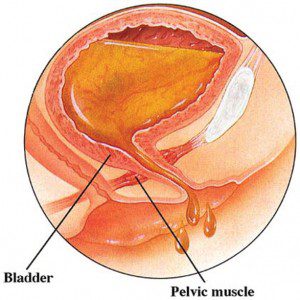By John W. Tillett, MD, Board Certified Urologist –
 Urinary incontinence is a common medical condition that affects over 40 million Americans, yet it often goes untreated or unrecognized. The reason for this trend is multifactorial, spanning from embarrassment to speak about this topic to dealing with more acute or morbid conditions that require focused attention.
Urinary incontinence is a common medical condition that affects over 40 million Americans, yet it often goes untreated or unrecognized. The reason for this trend is multifactorial, spanning from embarrassment to speak about this topic to dealing with more acute or morbid conditions that require focused attention.
Nevertheless, it is a treatable condition that frequently affects the quality of life of patients. Incontinence is classified as stress, urge, mixed and overflow.
In this article we will address some particular issues about urge incontinence.
Urinary urge incontinence (UUI) is defined as a sudden uncontrollable urge to urinate with or without frequent urination and associated leakage of urine. With urge incontinence, the bladder contracts and squeezes out urine involuntarily. Accidental urination can be triggered by:
• sudden change in position or activity
• hearing or touching running water
• drinking a small amount of liquid
Patients with overactive bladder symptoms, such as urinary urgency, frequency and nocturia, may have associated incontinence over 60% of the time. Though more common in women than men overall, after the age of 70 the prevalence in both sexes is about equal.
There are two bladder abnormalities that are associated to UUI: neurogenic overactivity and detrusor overactivity (DO).
Neurogenic bladder occurs when there is interruption in the normal nerve conduction from the brain or spinal cord above the sacrum to the bladder, and results in loss of bladder sensation and motor control. Conditions associated with neurogenic bladder include the following:
• Alzheimer’s disease
• Multiple sclerosis
• Parkinson’s disease
• Intervertebral disk disease
• Cerebrovascular events • Diabetes
• Traumatic brain or upper spinal cord injury
• Brain or spinal cord tumors
DO can occur due to multiple conditions, and many times as a sequelae of others; frequently, it may be idiopathic. Dysfunctions of the detrusor muscle or nerve pathways are the culprits for the bladder over-activity. Conditions that can lead to DO include:
• Bladder polyps and tumors
• Urinary tract infections • Bladder calculi
• Bladder outlet obstruction from BPH or stricture disease
Medications, such as diuretics, increase the urgency and frequency of urination in some people, especially the elderly and bedridden. Dosage modification may ameliorate the bothersome symptoms. Dietary habits may lead to significant voiding symptoms. Caffeine (e.g., in coffee, tea, chocolate), carbonated beverages, spicy foods and tomato-based foods can irritate the bladder and cause detrusor instability, resulting in urge incontinence.
The treatment and management of urge incontinence includes nonsurgical and surgical modalities. An important factor, however, is identifying the potentially morbid or life-threatening conditions that may lead to incontinence, such as bladder cancer, recurrent UTI or neurogenic disorders.
Anticholinergics have been shown to be very effective in the treatment of both neurogenic and idiopathic cause of UUI. As a class, side effects include confusion, dry mouth, constipation, dizziness, visual changes and urinary retention to name a few. Beyond medications there are simple yet effective treatments.
Advanced treatment modalities for refractory patients to conservative therapy and anticholinergics are available in the urologic armamentarium. Urological evaluation of these patients will most likely include a cystoscopy, urine cultures and urine cytology to rule out bladder pathology and bladder malignancies. As well, a detailed, computerized assessment study of bladder function called urodynamics may help the clinician in establishing the best treatment option.
Neuromodulation, either via sacral nerve pathways (Interstim) or peripheral nerve pathways (Urgent PC), have been shown to be very effective in the treatment of UUI in patients with refractory disease. These modalities are safe, FDA approved, minimally invasive and provide, through neural pathways, improvement in bladder function. Urgent PC is an outpatient, office-based, nonsurgical therapy that affects the sacral nerve plexus through retrograde pathways (posterior tibial nerve). Interstim utilizes the sacral nerve S3 to provide parasympathetic inhibition, thereby decreasing bladder over-activity. It is based on pacemaker technology, and effective in about 70% of refractory patients.
Injection of botulinum toxin (Botox) into the bladder muscle (intravesical injection) is an experimental treatment for refractory urge incontinence. This treatment has been shown to successfully reduce the instability that leads to urgency in both idiopathic and neurogenic patients.
Surgical urinary diversion is an invasive therapy used mostly for severe patients refractory to all other therapies.
Urinary incontinence is a common but overlooked problem. Urologic evaluation is warranted in refractory patients, or in patients in whom underlying bladder pathology or anatomic abnormalities, such as prolapsed, need to be addressed as well. Intervention beyond medications will significantly improve the quality of life of these patients.
Specialists in Urology
239-434-6300







